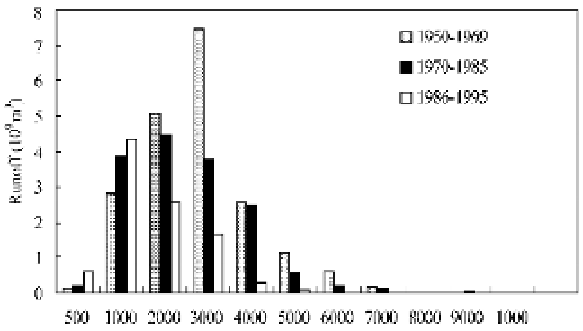Environmental Engineering Reference
In-Depth Information
billion m
3
and 0.36 billion tons less than the long term (1950-1990) average values, and those to the river
mouth were 17.2 billion m
3
and 0.42 billion tons, 23 billion m
3
and 0.58 billion tons less than the long
term average values. The main causes for the remarkable changes are attributed to soil conservation
projects and sediment trapping in the reservoirs in the upper and middle reaches, increasing water and
sediment diversion, and sedimentation in the lower reaches (Zhang et al., 1997).
Fig. 6.22
Comparison of runoff volume in the flood season (July-Sep) at different discharges at the Longmen
Hydrological Station for the periods 1950-1969, 1970-1985 and 1986-1995
In the past decade, the lower reaches changed rapidly in hydrological features. With the development
of reservoirs and irrigation projects upstream, less water was released to the lower reaches. Only 700
million tons of sediment was transported to the lower reaches annually due to sediment trapping projects
in the Loess Plateau and fewer rainstorms. Nevertheless, sedimentation in the lower reaches was not
eased by the reduction of sediment load. Between 1985 and 1994 the average sediment accumulation in
the lower reaches was 307 million tons during the non-flood season, of which 67 million tons were
scoured during the flood season, resulting in a net sediment deposition of 240 million tons per year. In
the meantime, on average 495 million tons of sediment were transported to the delta and into the Bohai
Sea per year. The huge amount of sediment deposition caused serious aggradation of the riverbed and
seabed. Table 6.6 lists the rise of the water stage at a discharge of 3,000 m
3
/s at the main hydrological
stations along the river in the period 1985-1994.
Table 6.6
Flood stage rise (at a discharge of 3,000 m
3
/s) at the main gauging stations along the lower reaches of
t
he Yellow River in the period 1985-1994
Hydrologic Station
Zhengzhou
Gaocun
Aishan
Jinan
Lijin
Distance from Lijin (km)
670
456
270
168
0
Stage rise (m)
0.99
0.93
1.13
1.35
1.62
Average rate of stage rise (m/year)
0.11
0.10
0.13
0.15
0.18
The stage rise is due to sediment deposition in the river channel. The important facts of sediment
movement in the lower reaches of the Yellow River are: (i) siltation takes place in the low flow season
and net scour occurs in the flood season; and (ii) scour occurs during the rising limb of a flood and
siltation occurs during the receding limb of a flood. Analysis of the data from the lower Yellow River
yield the following empirical formula relating the sediment load from scouring to the flow discharge:
'
Q
s
0 if
Q
1,800 m
3
/s
(6.1)














Search WWH ::

Custom Search